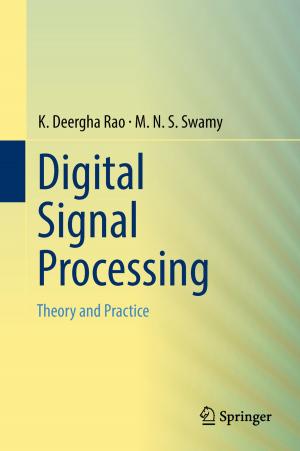Radar Cross Section of Dipole Phased Arrays with Parallel Feed Network
Nonfiction, Science & Nature, Technology, Microwaves, Science, Physics, Mathematical Physics| Author: | Hema Singh, H. L. Sneha, Rakesh Mohan Jha | ISBN: | 9789812877840 |
| Publisher: | Springer Singapore | Publication: | October 5, 2015 |
| Imprint: | Springer | Language: | English |
| Author: | Hema Singh, H. L. Sneha, Rakesh Mohan Jha |
| ISBN: | 9789812877840 |
| Publisher: | Springer Singapore |
| Publication: | October 5, 2015 |
| Imprint: | Springer |
| Language: | English |
This book presents the detailed analytical formulation for the RCS of parallel-fed linear dipole array in the presence of mutual coupling. The radar cross section (RCS) of an object represents its electromagnetic (EM) scattering properties for a given incident wave. The analysis of scattered field is critical in military and defence arenas, especially while designing low-observable platforms. It is well-known that the presence of an antenna/array on the target influences its echo area significantly. The primary cause for such scattering of the incident signals is reflection that occurs within the antenna aperture and its feed network. In this book, the RCS estimation is done based on the signal path within the antenna system. The scattered field is expressed in terms of array design parameters including the reflection and transmission coefficients. The computed results show the variation in the RCS pattern with and without mutual coupling. The effect of finite dipole-length, inter-element spacing, scan angle, array configuration, amplitude distribution and terminating load impedance on the RCS pattern is studied. It is shown that the array RCS can be controlled by choosing optimum design parameters, including terminating impedance and geometric configuration. This book explains each step of the RCS estimation and analysis of dipole array with detailed schematics, tables and illustrations. Moreover, it includes parametric analysis of RCS estimation and control. This book provides an insight into the phenomenon of scattering within the phased array system.
This book presents the detailed analytical formulation for the RCS of parallel-fed linear dipole array in the presence of mutual coupling. The radar cross section (RCS) of an object represents its electromagnetic (EM) scattering properties for a given incident wave. The analysis of scattered field is critical in military and defence arenas, especially while designing low-observable platforms. It is well-known that the presence of an antenna/array on the target influences its echo area significantly. The primary cause for such scattering of the incident signals is reflection that occurs within the antenna aperture and its feed network. In this book, the RCS estimation is done based on the signal path within the antenna system. The scattered field is expressed in terms of array design parameters including the reflection and transmission coefficients. The computed results show the variation in the RCS pattern with and without mutual coupling. The effect of finite dipole-length, inter-element spacing, scan angle, array configuration, amplitude distribution and terminating load impedance on the RCS pattern is studied. It is shown that the array RCS can be controlled by choosing optimum design parameters, including terminating impedance and geometric configuration. This book explains each step of the RCS estimation and analysis of dipole array with detailed schematics, tables and illustrations. Moreover, it includes parametric analysis of RCS estimation and control. This book provides an insight into the phenomenon of scattering within the phased array system.















